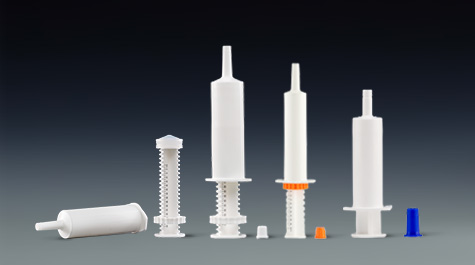Feb. 20, 2025
As market demands evolve, pharmaceutical companies are increasingly strict about packaging requirements. Beyond basic storage needs, more companies are focusing on the practicality and functionality of packaging. Veterinary syringes, as a highly functional packaging solution, are becoming a popular choice for drug packaging, particularly noted for their ability to reduce drug residue.
1. Basic Structure of Veterinary Syringes
Veterinary syringes consist of several key components: barrel, plunger, piston, protective cap, and positioning ring. When using the syringe, the user simply removes the protective cap and pushes the plunger to administer the medication. The design is sophisticated, utilizing hydraulic principles to facilitate the delivery of liquid, effectively minimizing drug residue and improving drug utilization.
2. Application of Hydraulic Principles in Veterinary Syringes
The operation of veterinary syringes is based on fundamental hydraulic principles, specifically Pascal's Law. This law states that in an incompressible static fluid, when an external force causes an increase in pressure at one point, this pressure increase is instantly transmitted to all points within the fluid. When the plunger is pushed, the drug solution flows from high-pressure areas to low-pressure areas, allowing the liquid to enter the body through a finer injection port, ensuring precise drug delivery.
3. Advantages of Reducing Drug Residue
The design of veterinary syringes can significantly reduce drug residue, which holds significant implications for both end users and pharmaceutical companies. For end users, reduced drug residue means higher utilization rates with each administration, minimizing waste due to residual medication. This not only enhances the efficiency of drug usage but also alleviates the financial burden on users.

For pharmaceutical companies, minimizing drug residue increases the added value of medications. This efficient packaging design not only helps enhance brand image but also allows companies to stand out in a competitive market. By reducing drug waste, companies can better control production costs and thereby improve overall profits.
4. Application Range
Veterinary syringes are widely used in areas such as bovine mastitis medication and pet nutritional pastes. In these contexts, accurate dosing and efficient utilization of drugs are particularly critical. As technology advances and market demands grow, the design and functionality of this packaging will continue to be optimized to meet the needs of more medications and diverse application scenarios.
With their innovative design and the application of hydraulic principles, veterinary syringes successfully reduce drug residue and enhance drug utilization. This packaging solution offers significant advantages for both end users and pharmaceutical companies, bringing convenience and benefits to the market.
 冀ICP备11016487号-1
冀ICP备11016487号-1